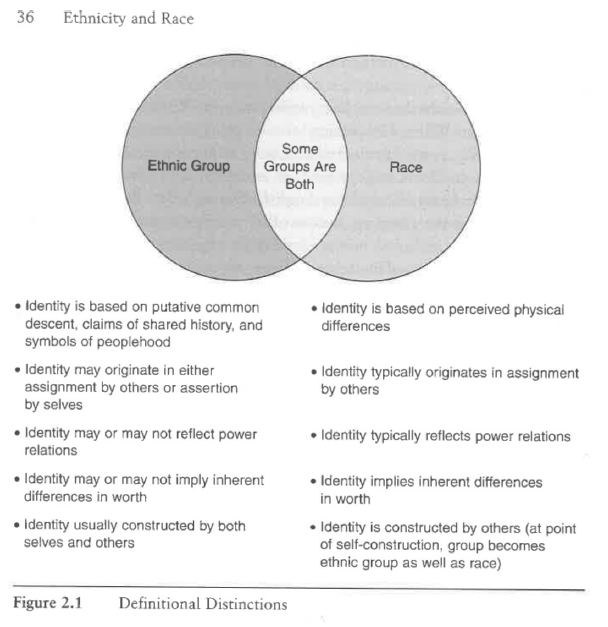Ethnicity & Race
Race and Ethnicity distinctively different, but incredibly difficult to distinguish. Ethnicity blossoms as a term in the 1960's with ethnic group and ethnic identity.
Ethnicity grew strong when distinguishing European descent: Irish Cliches grew from magazines and news papers depicting them as drunken party animals with the "Anger in their eyes" growing stereotypes.
Ethnic etymology comes from the Greek ethnos, meaning nation. Ethnikos from Latin also means "others" and "Heathens" showing that the term doesn't correlate with political basis.
Max Weber contributed towards the growth of the term in sociology and the academics.
Weber's contributions:
- Blood ties
- Common descent less important than belief of common discent
- Showing that ethnicity is strongly a social construct
- Basis of common descent varies from physical to cultural
- What is perceived?
- Exists among connections, distinctive connections
Schermerhorn added to this definition:
- Claim to kinship, broadly defined, and common history
- "Real or purative" common ancestry doesn't need to be based in strict fact
- Cultural distinctiveness is less relevant and sometimes not at all
- Subpopulation of a larger society
- self-conscious about ethnic identity
Race, Definition and Differences
Race can be more biological causing for great dispute over what distinguishable traits matter, how may races there are, and whether it varies from place to place.
Federal Government defined race in a inconsistent manner; sometimes classifying five races and other times more.
Some categorize 126 racial-ethnic groups.
Race emerged during the 15th and 16th century; Europeans wanted a means to categorize their blood as "pure" and began as means for Spanish to segregate against Jews.
In general, most racial categories were based upon color of the skin, but hypothesized on "scientific" factors such as intelligence or physical fortitude.
Social Construction of Race
Primary driving factors of race include government policy, popular mindset, and social actions.
Early distinctions tried to correlate sickle-cells with African Americans and exclude Welsh and Irish from Caucasian in order to justify judicial inequalities and even eugenics.
Laws in the South attempted to form definitions of race based on percentage heritage, such as Louisiana's 1/32nd African.
Differences between Race and Ethnicity
Ethnicity has been more fluid and easier to transcend due to the vague conceptualization it held while Race is a stronger conception due to the biological basis it attempts to ground itself in. An example of this is a Cambodian American losing the Cambodian ethnicity but still being depicted as the Asian-American Race.
Earliest European Colonists used Race to distinguish workers from adventurers, explaining that "lower races" were tools to be exploited and used for profit maximization.
Similarities between Race and Ethicity
Race and Ethnicity is difficult to use properly because both have been vaguely defined, redefined, and re categorized too many times that the lines overlap. This particularly comes into play during immigration discussions because race and ethnicity are both products of social interactions between diverse populations. They are typically held to be "natural" yet both are elastic to include attempts to make explainable connections between people.

@OriginalWorks
Downvoting a post can decrease pending rewards and make it less visible. Common reasons:
Submit
@OriginalWorks Mention Bot activated by @jpederson96. The @OriginalWorks bot has determined this post by @jpederson96 to be original material and upvoted it!
To call @OriginalWorks, simply reply to any post with @originalworks or !originalworks in your message!
For more information, Click Here!
Downvoting a post can decrease pending rewards and make it less visible. Common reasons:
Submit